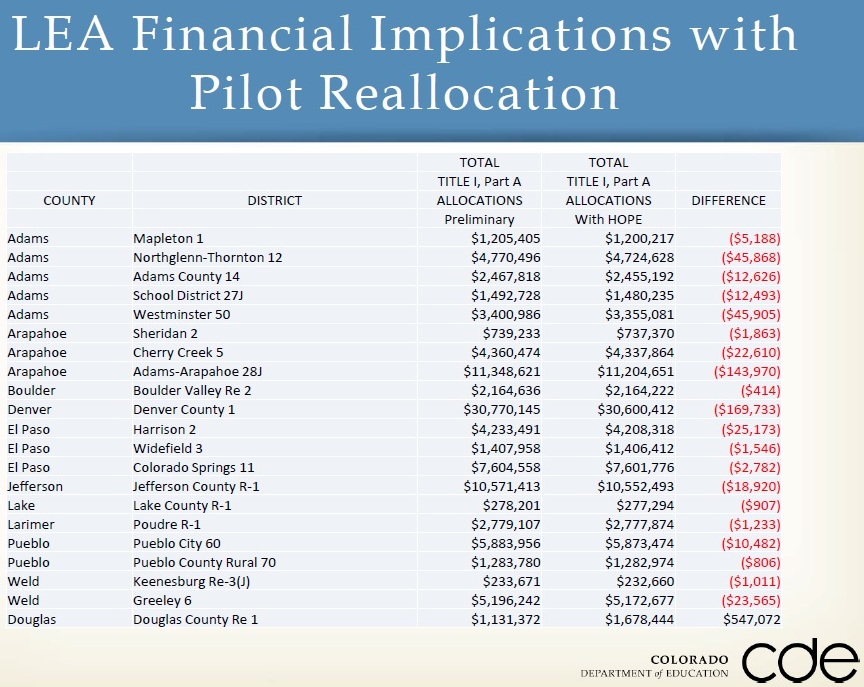Last week the Colorado State Board of Education took a relatively quiet action that may have profound results in years to come. The Board voted 6-1 to take steps toward redirecting a particular pot of federal Title I funds based not primarily on where students live, but rather on where they attend school. Title I money is allocated to support high-poverty schools.
As Chalkbeat Colorado reports, the decision means reshuffling more than a half million dollars to the benefit of the suburban Douglas County School District:
The two-year pilot is intended to account for students who attend the HOPE Online Learning Academy – Elementary but who live in other districts that now receive the Title I funding for those children. The $547,072 is the estimated shift of funds in 2014-15. A similar amount likely would be allocated in 2015-16.
I had to read through the story twice, because most of the quotes represented the view of the 1 vote rather than the 6. Given all these issues, I thought, how could a bipartisan group of officials overwhelmingly support testing the change? Clearly, there is more to learn, though the concerns raised by the Mapleton School District cannot be dismissed out of hand.
As you can see from the Colorado Department of Education chart I reposted below, a bunch of districts lose small but significant sums while Dougco comes out as the sole winner:

What gives, you might say? Why does a heavily affluent district like Dougco come out ahead? Because the district charters the HOPE Online Learning Academy, with learning centers scattered across the Front Range. HOPE serves a heavily low-income student population. Yet, based on existing federal Title I formulas, the dollars go to the districts where the students live rather than to the district that oversees their school and its funding.
In principle, I believe the pilot is a 100 percent great idea. Money should follow the student as closely as possible to make sure they are served. Yet as Chalkbeat points out, the funds are only guaranteed to go to the district level. That’s an improvement, and as long as there are district leaders looking out for the equity and interests of those students, it’s probably not a big deal. But I’d prefer to see the dollars go to the school and student level.
That clearly would put Colorado ahead of a pair of Congressional proposals empowering states to do just that. Seeing as how it’s been more than three years since this creative proposal was put forward publicly by former U.S. Congressman and State Board of Education chairman Bob Schaffer, the progress is worth celebrating but not exactly inspiring of fast-paced change.
For those who are keenly paying attention, you may ask a further question: Why is it just HOPE Online that’s affected by the pilot? It’s not the only multi-district online school serving a different batch of students geographically than reflected in its home base district. It ended up being the only one that fit CDE criteria — including participation in the federal school lunch program.
On another level, those of us looking for signs of positive innovation, the State Board’s move might be taken as approval of the first multi-district online pilot program, even before the HB 1382 commission has been chosen or seated. These days, I’m taking signs of progress wherever I can find them.







